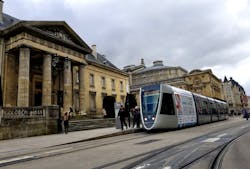In the past decade, there has been a trend toward using alternative off-wire power distribution technologies to minimize, and in some cases, eliminate overhead contact systems (OCS) for electrified transit systems. The visual effect of OCS to cityscapes, installation challenges and cost in urban areas, and the operating issues in shared rights of way have been the primary impetus for the development of these new technologies. There are many off-wire traction power systems, including in-ground contact systems, hybrid vehicles with onboard energy storage systems (OESS), and alternative fuel onboard energy generation systems.
Ground contact systems are like OCS in that vehicles, when moving, continuously collect power from a rigid conductor or distribution system as they travel. The main difference is collection occurs at ground level as opposed to 20 feet in the air. Hybrid systems rely partially on contact distribution systems, but also store energy onboard to provide traction power where OCS or other distribution systems are not installed. Onboard energy generation systems use alternative fuels, such as hydrogen, to generate electric power for vehicles instead of collecting power from wayside infrastructure.
To date, ground contact systems have not been implemented in the United States, but several are in use in other countries. Several hybrid vehicle systems are in operation in the US, while other off-wire systems are in various stages of development. Hybrid vehicle systems, in some cases, have been coupled with quick-charging stations to implement a true wireless system.
Ground contact system (GCS)
The GCS features an embedded “third rail” centered on the track with 8-meter conductive segments separated by 3-meter isolation segments. The conductive segments are powered only when the vehicle travels over them. The power infrastructure uses substations with feeder cables like OCS, but ground contact systems have vehicle detection systems to control embedded switchgear along the alignment. The ground contact system has drawbacks, particularly higher capital costs than other options and a scarcity of suppliers, contributing to the lack of implementation in the US. However it has an advantage over pure contactless options on an alignment with significant uphill grades.
On-board energy storage system (OESS)
Most US authorities have chosen hybrid vehicles powered by an OESS for off-wire systems. This potentially decreases capital costs by removing some, or all, of the OCS. However, it increases long-term maintenance costs because the expected OESS life span is only 5 to 8 years. Current US projects use batteries within the OESS. Supercapacitors can be used, but only for specific applications. OESS capacity is limited due to vehicle weight and space limitations; longer vehicles usually can have a larger OESS since they have more roof space. Systems using a combination of batteries and supercapacitors offer better charging performance and braking energy recapture, but require more space to implement and are more suitable for light rail vehicles or 5-section and longer streetcars. Due to the advances in battery technologies, combined systems have not been recently proposed. The OESS can be charged via an OCS, an overhead charge bar, an embedded charge bar similar to a single segment of a ground contact system, or by an inductive charging system.
Onboard energy generation
Vehicles with onboard energy generation systems use fuel cells, batteries, and hydrogen to generate power. Their only limitation is the availability of fueling stations to replenish hydrogen supply; conventional electrical supply infrastructure is not required. The major disadvantage is the required space and added weight of the fuel, tanks, fuel cells, and batteries.
Comparative analysis
Wireless traction power systems provide benefits in specific urban applications, and each method has advantages and disadvantages.
Considerations for wireless systems implementation
Now that the technology for off-wire operation is available, it will continue to be an important option for electrified transit systems. Power simulations are an integral part of system selection. Selection factors include:
- Hybrid OESS systems don’t work well on long uphill grades, due to power requirements
- OESS using supercapacitors need predictable travel time, and perform better in dedicated rights of way
- OESS using batteries have greater range and are recommended for mixed traffic
- Wireless regions should start and stop at stations
- Current collection devices must be stowed and de-energized when operated through wireless regions
- OESS quick-charging should be implemented at stations
- For any systems (mixed, contact wire, wireless segments, or ground contact), where quick-charge stations are not implemented
- Traction power load flow studies should include OESS charging
- OESS charge time should correspond with time on wire
Jason Krause, P.E., is a principal engineer with LTK.



